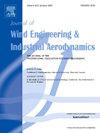Study on snowdrift characteristics and corresponding control measures for elevated buildings in Arctic region
IF 4.9
2区 工程技术
Q1 ENGINEERING, CIVIL
Journal of Wind Engineering and Industrial Aerodynamics
Pub Date : 2025-10-04
DOI:10.1016/j.jweia.2025.106245
引用次数: 0
Abstract
The melting of Arctic sea ice offers new opportunities for commercial use of the Arctic Passage. However, severe snow drifting environments in this region often cause snow-related disasters, such as traffic congestion and structural burial, challenging the development of the Arctic Passage and coastal ports. To withstand snowdrift disasters, elevated structures have been commonly used in the Arctic. Therefore, this study aims to explore the snowdrift characteristics and corresponding control measures for Arctic elevated buildings. Initially, a wind tunnel test of snowdrifts around a scaled elevated building was carried out based on the analysis of the typical adverse meteorological conditions in Arctic region. Through the comparison with test results, a numerical method was validated and used to investigate the measures of snow reduction and prevention for elevated buildings. The results show that the elevated structures can effectively reduce surrounding snowdrifts by accelerating airflow beneath the building. Increasing elevated height and lateral elevated pillar columns may lead to more even snow distributions, while widening and shortening wind channels between elevated pillars can effectively control snowdrifts under the elevated layer.
北极地区高架建筑积雪特性及控制措施研究
北极海冰的融化为北极航道的商业利用提供了新的机会。然而,该地区恶劣的积雪环境经常造成交通拥堵和结构掩埋等雪灾,给北极航道和沿海港口的发展带来挑战。为了抵御雪堆灾害,高架结构在北极地区被广泛使用。因此,本研究旨在探讨北极高架建筑的积雪特征及相应的控制措施。首先,在分析北极地区典型不利气象条件的基础上,进行了规模高架建筑周围积雪的风洞试验。通过与试验结果的对比,验证了数值方法的有效性,并将其应用于高架建筑降雪和防雪措施的研究。结果表明,高架结构可以通过加速建筑物下方的气流,有效减少周围的积雪。增加高架高度和横向高架柱可以使积雪分布更加均匀,而加宽和缩短高架柱之间的风道可以有效地控制高架层下的积雪。
本文章由计算机程序翻译,如有差异,请以英文原文为准。
求助全文
约1分钟内获得全文
求助全文
来源期刊
CiteScore
8.90
自引率
22.90%
发文量
306
审稿时长
4.4 months
期刊介绍:
The objective of the journal is to provide a means for the publication and interchange of information, on an international basis, on all those aspects of wind engineering that are included in the activities of the International Association for Wind Engineering http://www.iawe.org/. These are: social and economic impact of wind effects; wind characteristics and structure, local wind environments, wind loads and structural response, diffusion, pollutant dispersion and matter transport, wind effects on building heat loss and ventilation, wind effects on transport systems, aerodynamic aspects of wind energy generation, and codification of wind effects.
Papers on these subjects describing full-scale measurements, wind-tunnel simulation studies, computational or theoretical methods are published, as well as papers dealing with the development of techniques and apparatus for wind engineering experiments.

 求助内容:
求助内容: 应助结果提醒方式:
应助结果提醒方式:


